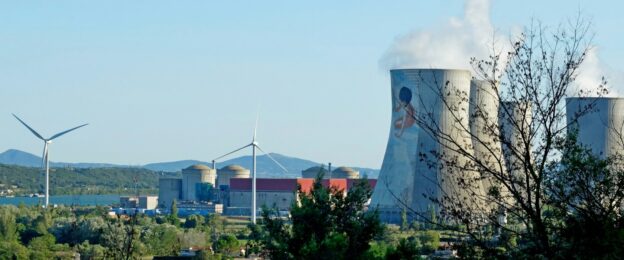- U.S. electricity demand is soaring due to rapid growth in AI data centers and the planned reshoring of manufacturing.
- Natural gas is expected to supply 60% of the additional power demand, while renewables will provide 40%.
- Despite demand growth, data center buildout may be slow due to permitting and construction timeline.

AI data centers and the reshoring of some manufacturing will drive U.S. electricity demand growth over the coming decade.
The world’s biggest economy will need all energy sources to ensure power demand is met. Natural gas is the biggest near-term winner of AI advancements, but renewables will also play a key role in powering the data centers of next-generation computing, analysts say.
The U.S. has seen a surge in proposed data centers over the past year.
As of July 2024, Wood Mackenzie had identified about 50 gigawatts (GW) of proposed data centers in America. This figure had doubled in a few months, and the proposed data centers were nearly 100 GW by January 1, 2025, according to WoodMac’s estimates.
Policy and regulation “will need to reflect the reality that there is a need for all generation technologies,” according to Wood Mackenzie’s analysts, as the natural gas boom alone cannot meet the soaring electricity demand.
AI-Led Power Demand Surge
AI data centers are set to account for almost half of U.S. power demand growth by the end of the decade, the International Energy Agency (IEA) said in its Energy and AI report last week. Driven by AI use, America will consume more electricity for data centers than for the production of aluminum, steel, cement, chemicals, and all other energy-intensive goods combined, according to the agency.
The U.S. and other key power markets will tap a diverse range of energy sources to meet rising electricity needs from data centers. But renewables and natural gas are set to take the lead due to their cost-competitiveness and availability in key markets, including the U.S., the IEA said.
By 2035, data centers are set to account for 8.6% of all U.S. electricity demand, more than double their 3.5% share today, BloombergNEF said in a new report this week. U.S. data-center power demand will more than double over the next decade, rising to 78 GW in 2035 from nearly 35 GW in 2024.
Related: US Oil Production to Peak in 2027, Natural Gas by 2032: EIA
Goldman Sachs, for its part, sees U.S. electrical power demand rising by 2.4% each year through the end of the decade, with AI-related demand accounting for about two-thirds of the incremental power demand in the country.
“The US is reaching a power demand inflection point due to the rise of energy-intensive artificial intelligence (AI), the need for more AI-ready data center capacity, and the reshoring of manufacturing,” Goldman Sachs analysts wrote in a report earlier this year.
The higher power demand will be met by a diverse mix of energy sources. While renewable energy is growing in the mix of power generation sources, natural gas is best positioned to capture the majority of incremental capacity growth, while nuclear energy’s impact is unlikely to be felt this decade, according to Goldman Sachs.
Who Will Power the AI Boom?
Natural gas is set to provide 60% of the incremental generation capacity related to data center demand, while renewables are expected to provide the remaining 40%, the investment bank’s analysts said.
Renewable investments could drop by 30% or more in the coming years if the Trump Administration axes key incentive provisions in the Inflation Reduction Act (IRA), WoodMac says.
“But despite these concerns, buyers are showing a willingness to pay a premium for renewable energy,” WoodMac’s analysts noted.
Natural gas is winning big from the Trump pro-fossil fuel policies and the U.S. power demand surge, and gas is leading the efforts to power a large part of the extra electricity demand.
Gas capacity orders jumped by 146% in North America last year-the most in nearly a decade, and gas turbine orders increased by 36% year-on-year in 2024, said WoodMac.
“But gas alone cannot meet the rising electricity demand,” it added.
Demand is rising, but there are uncertainties about how high the growth would be and how fast the data centers will be built.
BloombergNEF (BNEF) has a relatively conservative forecast about U.S. data center buildout. This is not due to skepticism about AI’s market potential “but acknowledges real-world deployment challenges such as securing key elements (land, power, permits) and navigating the complex construction process,” said BNEF’s Helen Kou, Head of US Power, and Nathalie Limandibhratha, Senior Associate US Power.
The research firm has estimated that the development of a data center in the United States would typically take about 7 years-from initial planning to full operation. This timeframe includes 4.8 years in pre-construction and 2.4 years for construction.
Still, the U.S. will be the world’s most important market in power demand growth for data centers, BNEF said in a separate report this week.
“Over the next five years, demand from US data centers could outpace even electric vehicles’ incremental demand, driven by the surge in AI training workloads that require significant compute capacity and highly energy-dense infrastructure,” according to BNEF.
Amid surging power demand, natural gas will play a crucial role in meeting incremental U.S. electricity consumption. Renewables and potentially nuclear in the longer term will also provide the additional power needs.
https://oilprice.com/Energy/Energy-General/Soaring-US-Power-Demand-Will-Need-All-Energy-Sources.amp.html





